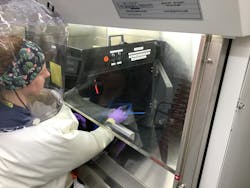Signify today announced that Boston University has determined that a Signify ultraviolet (UV) light source would almost always deactivate the coronavirus that causes COVID-19 if dosed at the right level.
The university’s National Emerging Infectious Diseases Laboratories (NEIDL) exposed materials containing the virus to a UV-C tube lamp from Signify. It found that a dose of 5 mJ/cm2 resulted in “a reduction of the SARS-CoV-2 virus of 99% in 6 seconds.” (SARS-CoV-2 is the more scientific name for the novel coronavirus).
The NEIDL team extrapolated that a stronger dose of 22 mJ/cm2 would result in a reduction of 99.9999% in 25 seconds.
“Our test results show that above a specific dose of UV-C radiation, viruses were completely inactivated: In a matter of seconds we could no longer detect any virus,” said team leader Anthony Griffiths, associate professor of microbiology at Boston University. “We’re very excited about these findings and hope that this will accelerate the development of products that can help limit the spread of COVID-19.”
The results come less than two months after Signify CEO Eric Rondolat said the company would gear up its UV disinfection research and products amid the coronavirus pandemic.
Rondolat today said that Signify plans to share the university-validated technology with other lighting companies. It was not immediately clear whether Signify will license it or offer it through some other means.
“Given the potential of the technology to aid the fight against the coronavirus, Signify will not keep the technology for its exclusive use but make it available to other lighting companies,” Rondolat said today. “To service the growing need for disinfection, we will increase our production capacity multifold in the coming months.”
Signify provided Boston University with a 35W Philips TUV light source emitting at around 254 nm, LEDs Magazine has learned. Philips TUVs are tubular UV lamps aimed at the germicidal market, typically used for air and water disinfection and similar applications.
Signify, formerly called Philips Lighting, still uses the Philips product brand name. It has been offering UV products for over three decades.
The Signify lamp at Boston University appears not to be a newly developed one but to have come from Signify’s existing stable, using mercury discharge technology, which is a more established method for disinfection lighting than are LEDs.
“There are applications in which UV-C LEDs can be used, but the majority of our focus is currently on conventional UV-C lamps as these are still much more effective than UV-C LEDs,” a Signify spokesperson told LEDs. “However, we do have a UV-C LED module which is designed to fit appliances where conventional mercury discharge lamps are too big to be integrated, such as refrigerators, coffee machines, air humidifiers, ice makers (and the like).”
Some industry experts might dispute that mercury discharge is more effective than LEDs for disinfection. But mercury is probably less expensive. Research into the use of UV LEDs continues, including both UV-A-band and UV-C band studies, and interest has run high in commercial products for disinfection and sanitation applications.
A corona zapper could conceivably have applications in many settings, including hospitals, public transportation, offices, retail stores, and supermarkets to name just a few. It would come with the caveat that UV-C can be dangerous if not used or designed into end products correctly, as LEDs has been reporting. Indeed, on June 18 Bob Karlicek, director of the Center for Lighting Enabled Systems & Applications (LESA), will address both fact and fiction regarding UV-C for germicidal applications in a live webcast. Register for the live event or to access it on demand and get an expert engineering and scientific point of view.
LEDs will bring you more on this story as we get it.
MARK HALPER is a contributing editor for LEDs Magazine, and an energy, technology, and business journalist ([email protected]).
For up-to-the-minute LED and SSL updates, why not follow us on Twitter? You’ll find curated content and commentary, as well as information on industry events, webcasts, and surveys on our LinkedIn Company Page and our Facebook page.





